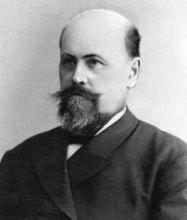Kitner Iyeronim Sevastyanovich (1839, Saint-Petersburg - 1929, Leipzig) - russian architect, teacher, public figure. In 1853 - 1859 he studied at the St. Petersburg Construction School, in the early 60's he worked with A. Shtakenshneider on the construction of the Mykolayiv Palace.
From 1863 to 1867 he continued his studies and work abroad in the Russian Empire. After returning, he worked as an assistant of architect A.I. Rezanov on the construction of the palace of Grand Duke Vladimir Alexandrovich on the Palace Embankment, house 26 (1867-1872).
Professor of the Construction School - Institute of Civil Engineers and the Institute of Railway Engineers. One of the founders and editor of the magazine Architect.
In 1867 he received the title of academician of architecture for the project of the khutor, since 1911 - an honorary member of the Academy of Arts of Russian Empire. Chairman of the St. Petersburg Association of Architects (1905-1917).
He was elected a speaker of the St. Petersburg City Duma. He had the rank of secret adviser. He was a member of the board of the Ministry of Railways.
In 1918 he emigrated to Germany.
Iyeronim Kitner worked in the stylistic forms of the Neo-Renaissance, Neo-Baroque, developed and implemented the so-called brick style.
He built a lot in St. Petersburg - the Agricultural Museum in the Salt Town, the indoor market on Hay Square, the Institute of Civil Engineers, the City Hall, the buildings of Alexander Hospital, the houses of Siegel, Rezanov, Strauss and others, in Moscow - Engineering School, Upper Rows and more.
He performed a number of works for Ukraine.
According to Kitner's competition project, the Ekaterinoslav architect F. Hagen built a chapel at Lozova station (1890). He designed the facade of Pavlov's house in Ekaterinoslav, also built by F. Hagen.
He won the competition of projects for the complex of Kyiv Polytechnic Institute (implemented in 1899-1900 under the leadership of O. Kobelev),
In Kyiv, according to Kitner's project, the Oleksiyivka shelter for military children was built (1901 - 1902 pp.).
He has repeatedly appeared in the press on the development of architecture of the XIX century, for example: Brick architecture // Architect. - 1882. - №8.
Volodymyr Tymofienko. Architects of Ukraine in the late XVIII - early XX centuries. Biographical guidebook

